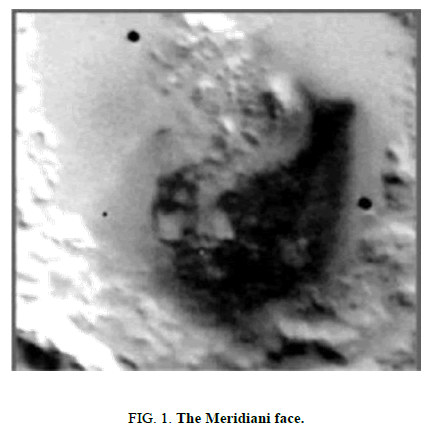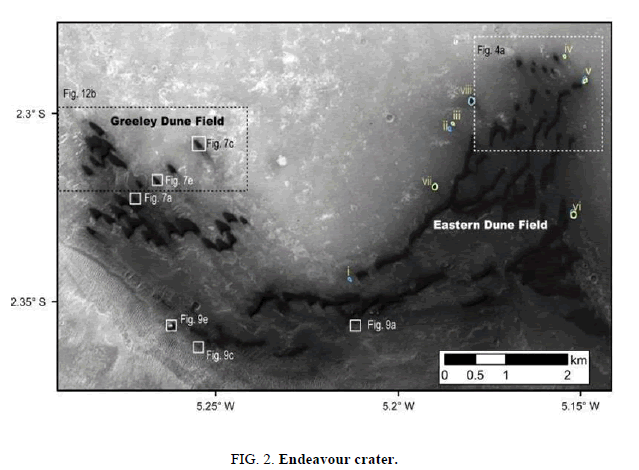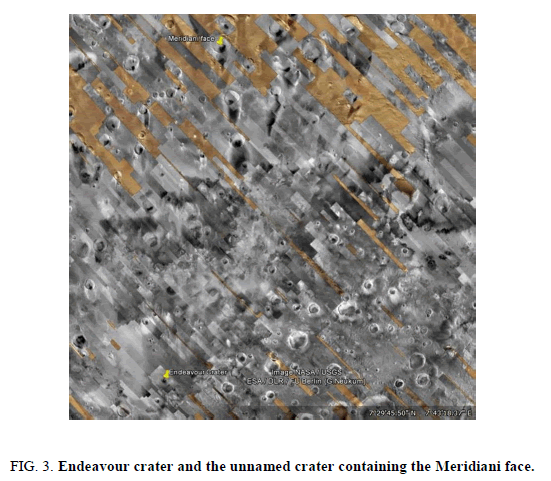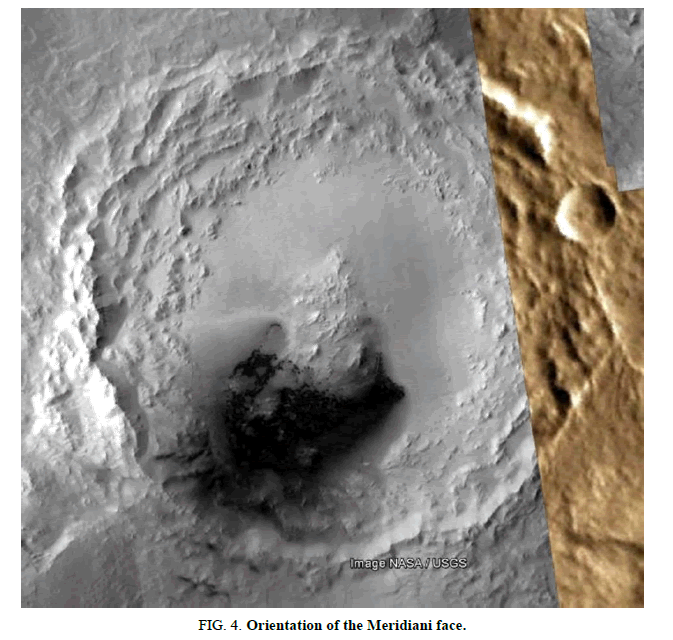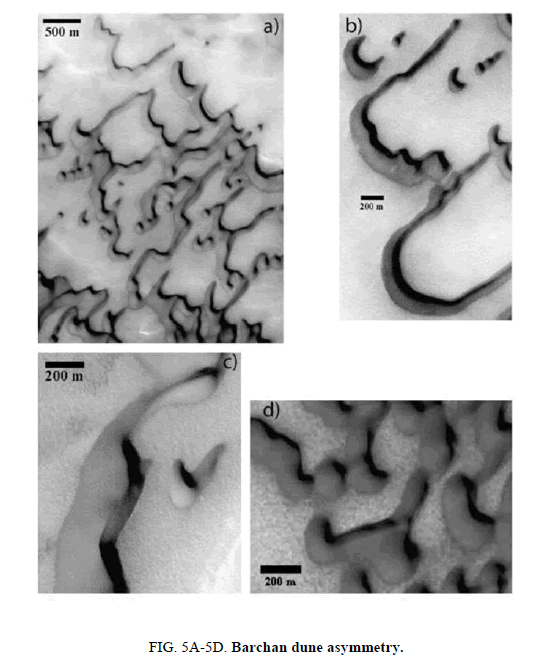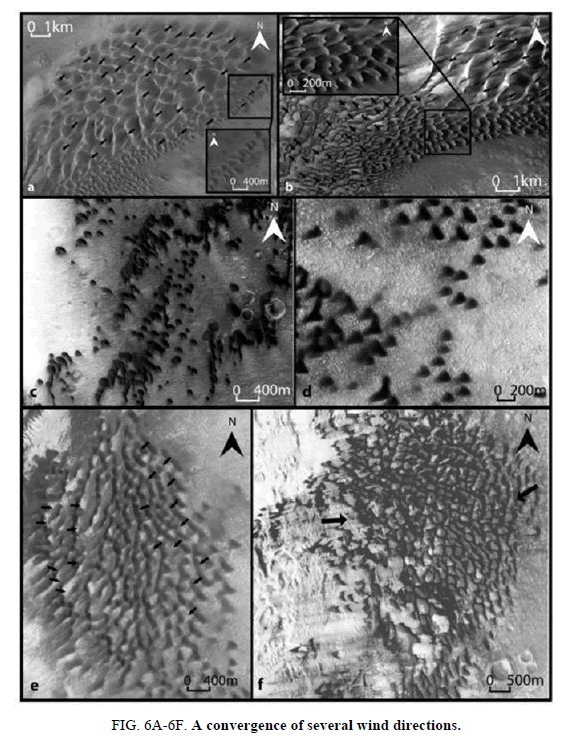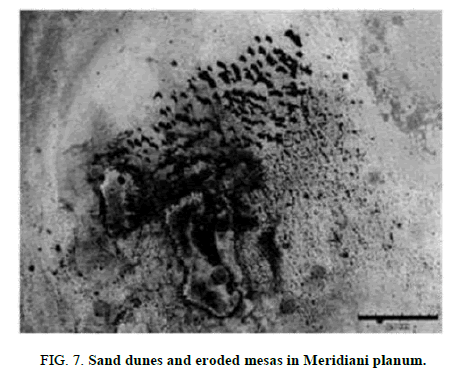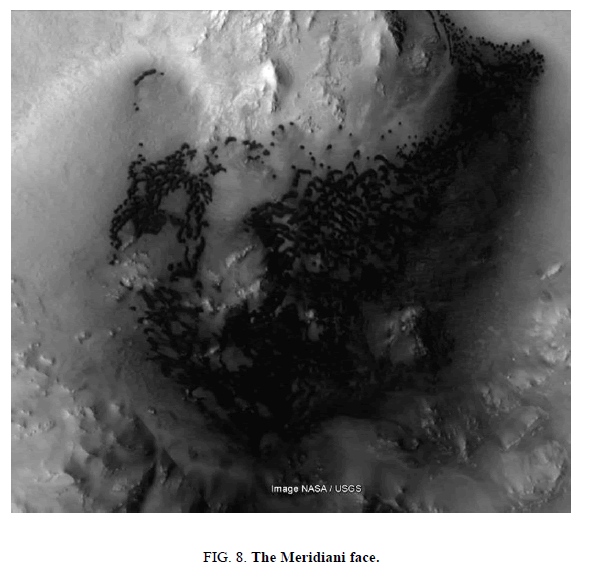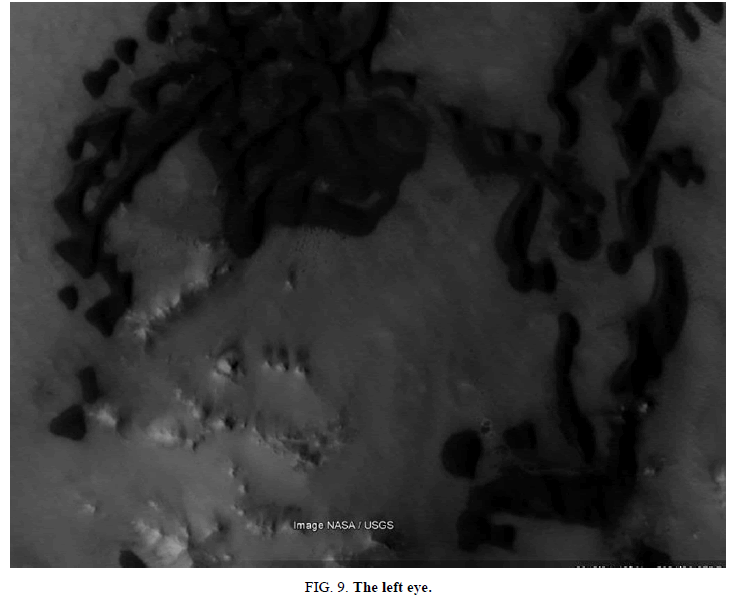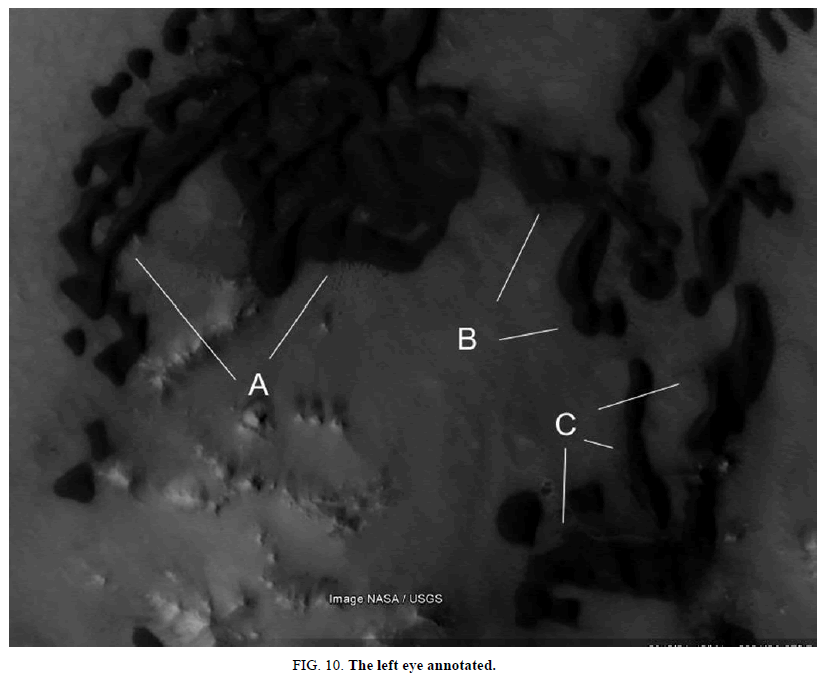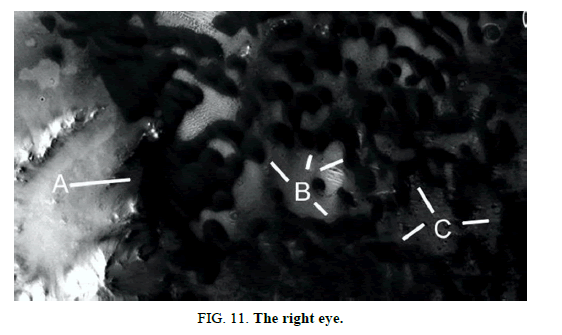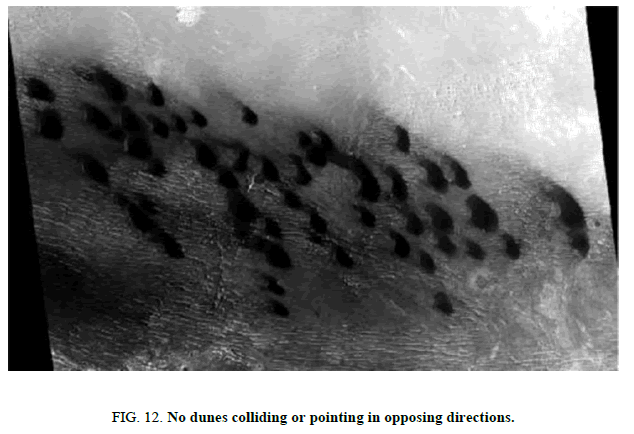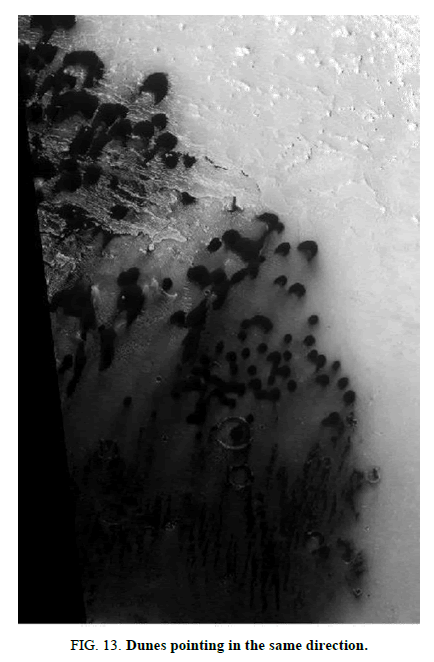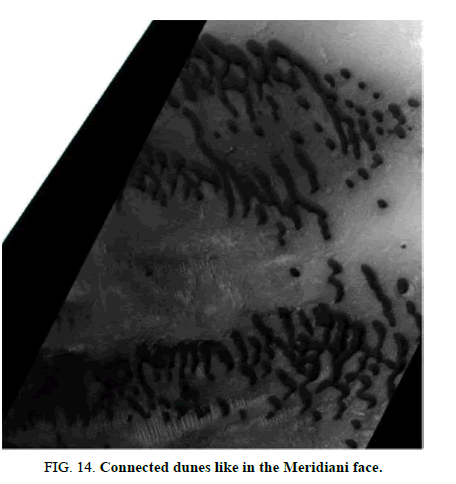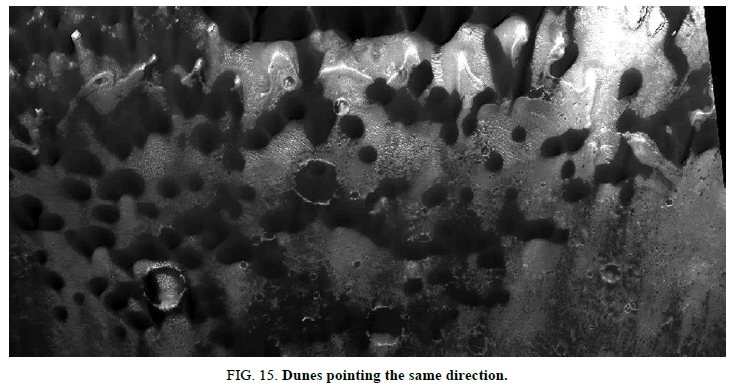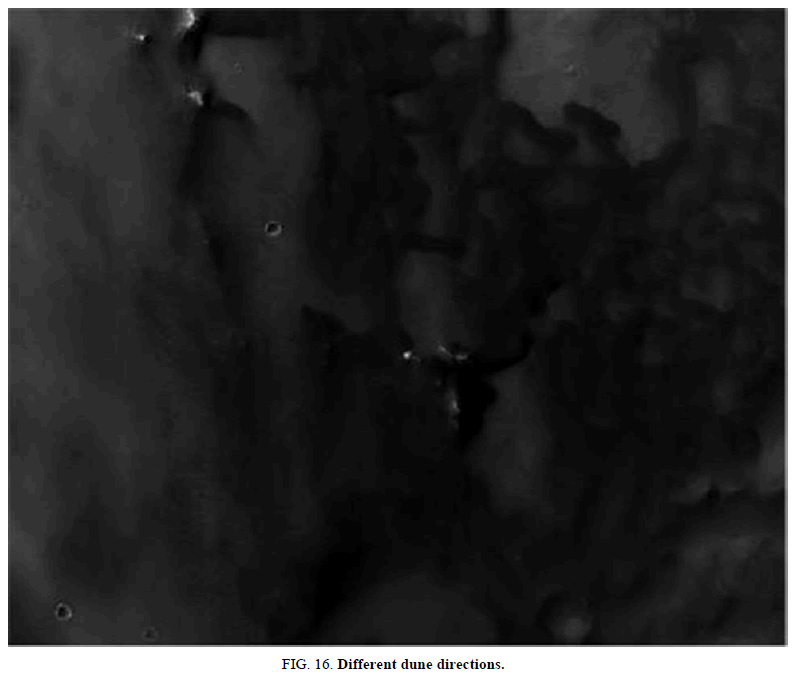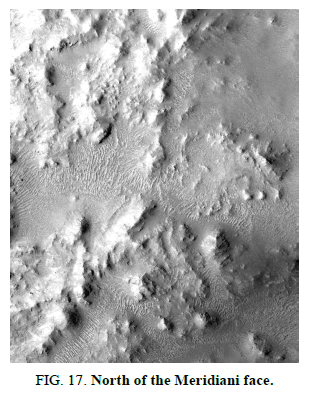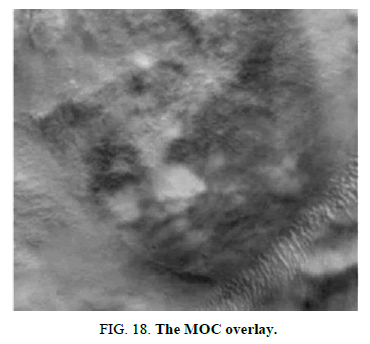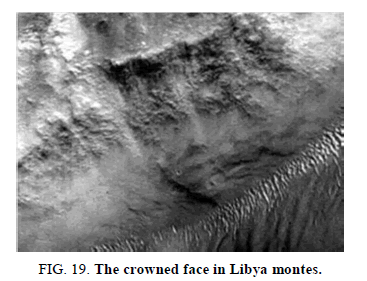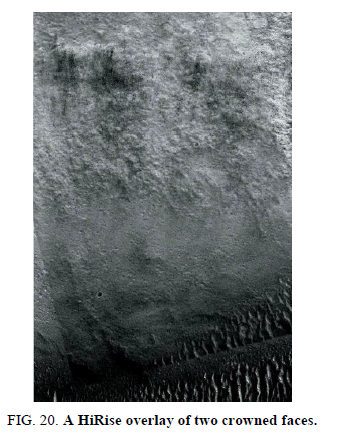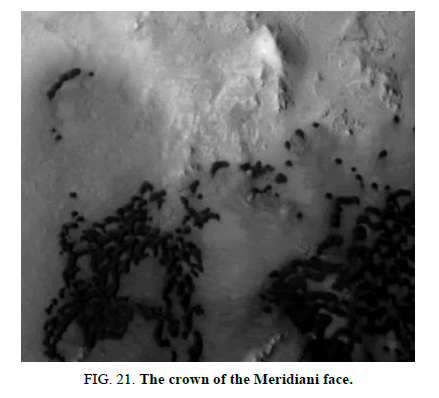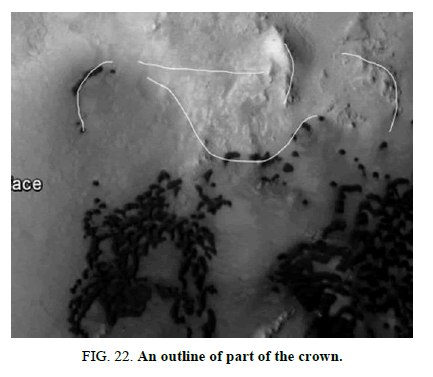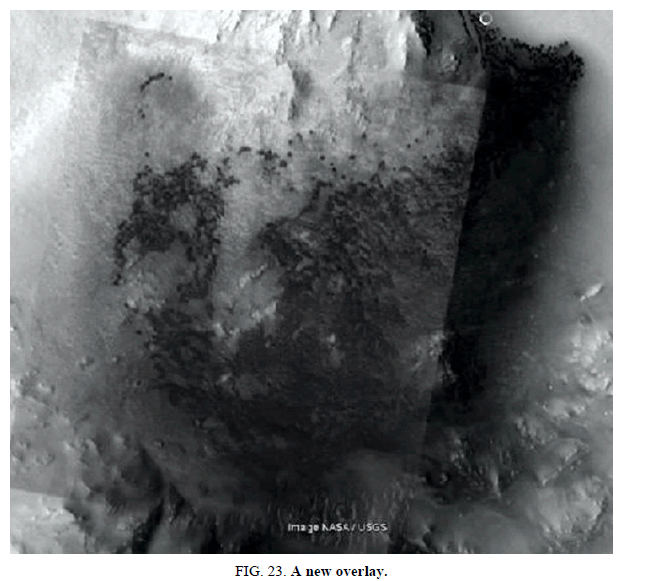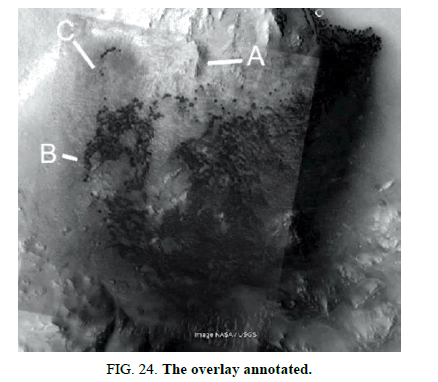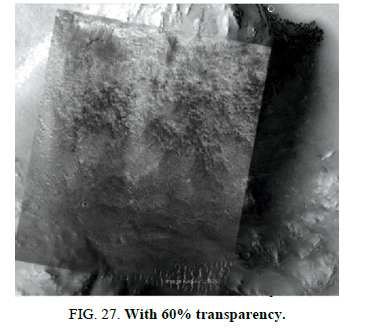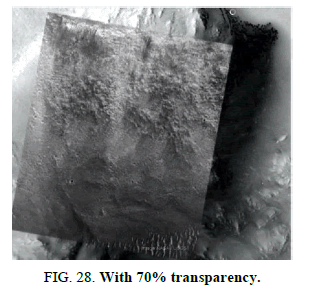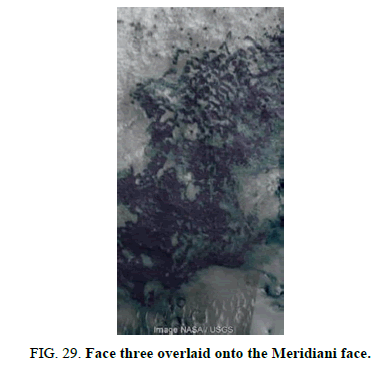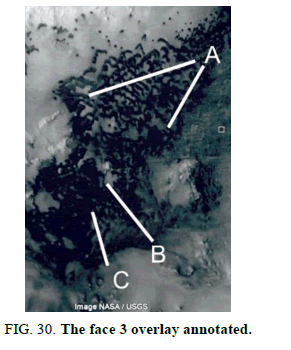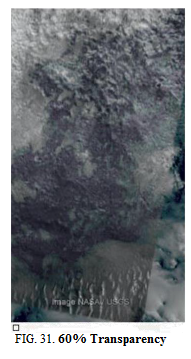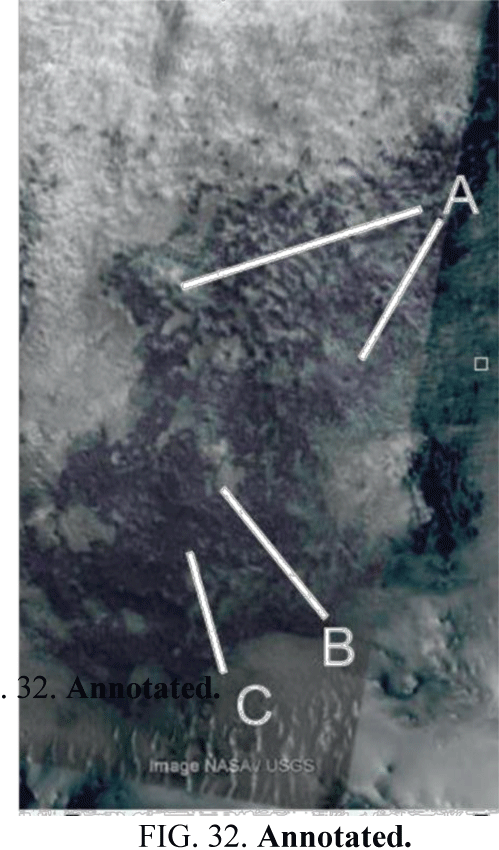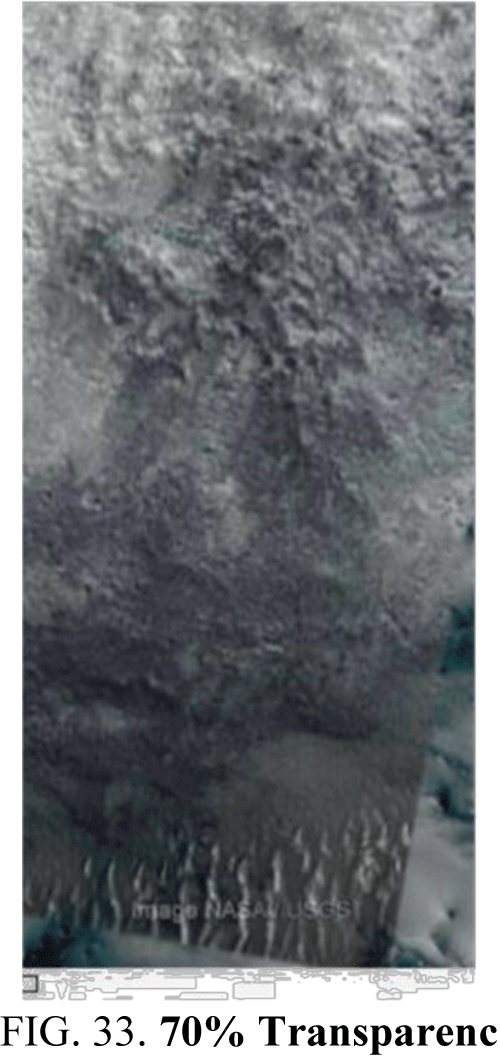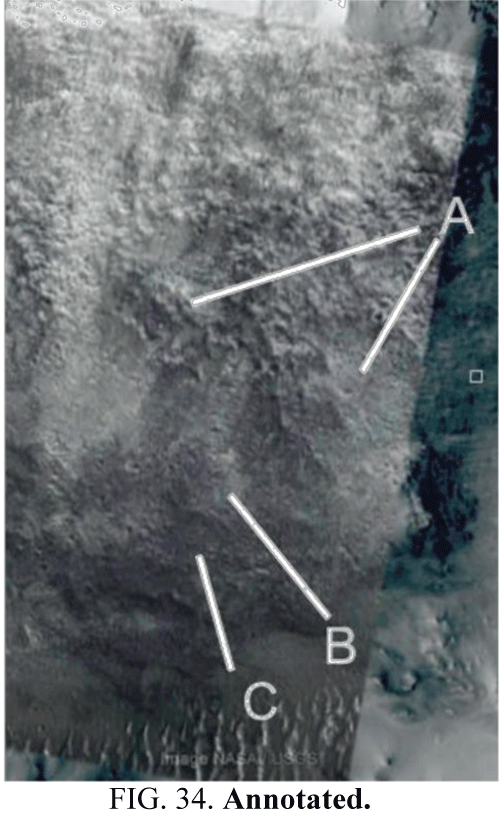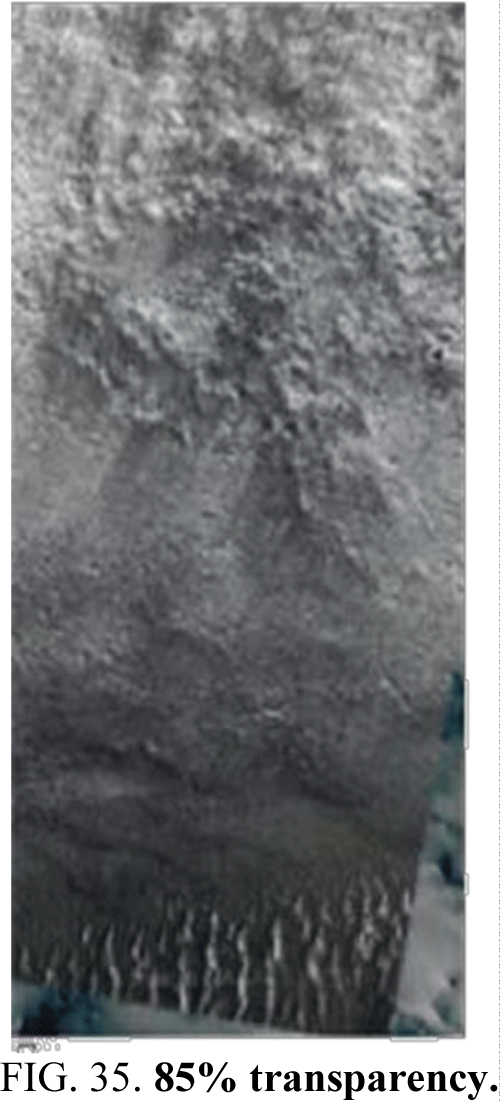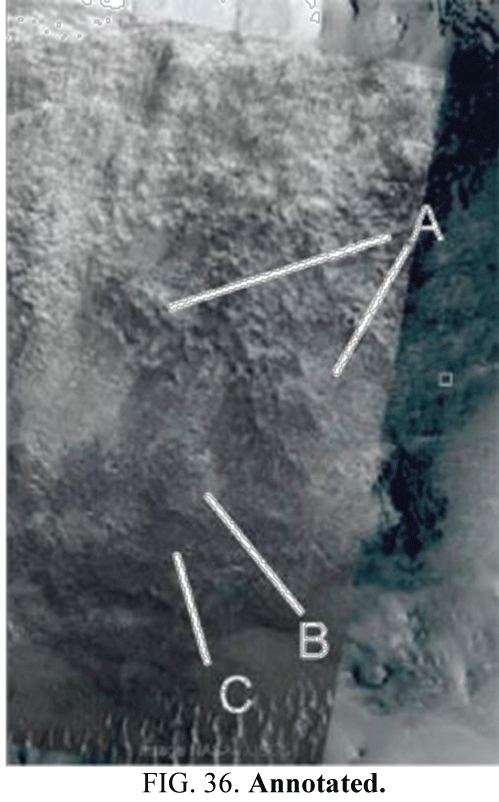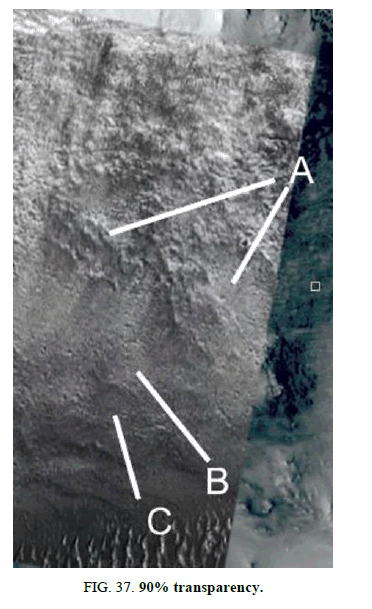Original Article
, Volume: 6( 1)The Meridiani Face on Mars
- *Correspondence:
- Greg Orme , School of Arts and Science, Undergraduate Science Student, University of Queensland, Brisbane, Australia, Tel: 07-33656195; E-mail: Gregory.orme@uqconnect.edu.au
Received: September 11, 2016; Accepted: November 25, 2016; Published: December 25, 2016
Citation: Greg O. The Meridian Face on Mars. J Space Explor. 2016;6(1):108.
Abstract
The Meridian Face has some similar features to the Cydonia and Crowned Faces such as having a crown. It is similar to the Nefertiti formation in that it seems to be made of dark soil, dunes in this case. Some dark dune fields can migrate large distances in Meridiani Planum, others remain confined in larger craters perhaps by shielding them from the wind. This can allow for the formation to be very old and remain intact. The similarity between the Crowned Face in the King’s Valley Libya Montes and the Meridiani Face was originally shown with an overall. The implicit hypothesis was that a new overlay would match the two faces even more closely, this has been borne out with the Crowned Face HiRise image and the Meridiani Face CTX image.
Keywords
Meridiani planum; Barchan dune; Aeolian process; pareidolia; Dune migration
Introduction
The Meridiani Face was discovered around early June 2007 by a Mars researcher Terry James, (Figure 1). The null hypothesis is that this is a random dune formation, an example of people’s innate ability to see faces [1]. It is proposed that this is falsified by the shape of these dunes, to be artificial they would have had to be moved to their current positions. By comparing them to naturally formed dunes the discrepancies between the two processes are shown. Dune fields in Meridiani Planum craters are probably formed from layers of volcanic ash [2], these are usually constrained within the crater rim. One hypothesis is there is an unknown process stopping these dunes migrating [3], saltation occurs as the dunes change shape but do not move significant distances [4]. Another hypothesis is the crater rim shields them from enough wind to migrate them significant distances [4]. Cardinale et al. [5] suggest the topography can account for the variations in the dune shapes such as in the Meridiani Face. Other possible artifacts on Mars, such as the Crowned Face in Libya Montes [6] probably date to when Mars had a paleosea and thicker atmosphere. To have a common origin the Meridiani Face should have an equivalent age of several billion years.
Pareidolia
Recognizing faces, often referred to as pareidolia, is sometimes considered to be an innate ability people have [1]. Inverted faces are more difficult to recognize [7], also the more distorted or jumbled they are the more time it can take to recognize them. It can then be a different kind of ability [8]. Inverted faces are more difficult to recognize [7], also the more distorted or
jumbled they are the more time it can take to recognize them. A special part of the brain may recognize faces but not other kinds of Martian formations [9]. This problem has often occurred as researchers examined Mars images for possible artifacts. Amateurs and scientists [10] such as in the Society for Planetary SETI Research originally began this research because of the public availability of these images from NASA online. Some then found face-like or other artificial looking shapes and began to analyze as the Cydonia Face [11]. Many could be explained by pareidolia while a few were much harder to dismiss. [12] was another of the first peer reviewed papers to examine the Cydonia Face in the Viking images. Other papers [13] tried to form a hypothesis about these formations. While the face was most easily recognized and caught the attention of the public, others formations were found such as a complex geometric pattern of mounds [14].
Lewis and Ellis [1] also question as to whether our expertise at recognizing faces is instinctive or comes with experience. We might then be more familiar with faces and preferentially search for them in clouds for example, hence the term pareidolia. It begs the question then as to whether researchers have found some faces on Mars because those artifacts happened to be faces, or because they kept looking for things they would unconsciously recognize like a Rorschach Test of inkblots. In this hypothesis the variations in Martian topography would create so many random shapes that researchers would find whatever they unconsciously wanted to. This can give rise to a circular argument that the faces should be dismissed because they look too much like us. However, a similar argument might be made if they did not look recognizably organic, that they should be dismissed as merely an unusual unknown shape.
Purcell and Stewart [15] found that a conventional face was more quickly recognized than a jumbled face, however researchers looking at tens of thousands of Mars images usually take their time rather than jump to conclusions. They often turn an image around and zoom into some areas, it is unlikely then that rapid analysis of images like in this experiment preferentially led to faces being found. Also, many have been found at different orientations with few happening to be vertically orientated or in pristine condition. Lewis and Ellis [1] suggest there may be a special part of the brain to detect faces, however this is not known to exist as a certainty. Other shapes such as of buildings, birds, and fish have also been found which would not use this specialized ability. Also the Martian faces are not recognized by face algorithms like on Facebook [16], they then appear humanoid but people rarely see them as looking exactly like humans.
Liu et al. [17] conducted an experiment to see how people detect faces in noisy data. In some cases, this can happen in Mars images when the objects looked for are small or the image has blocky JPG compression. However, the Meridiani Face is quite large and was even visible in the Viking images with a resolution of tens of meters per pixel. As will be shown, very small details are visible in the latest HiRise images as small as in centimeters per pixel. Sheen and Jordan [18] discuss how pareidolia might occur with low light conditions, however the dark dunes of the Meridiani Face have a high contrast against the light topography of the crater. There is then little noise and fuzziness in these images, the data looks like a face nonetheless.
Another problem with the pareidolia argument is that it arose when the Cydonia Face was first discovered in the 1970s, with only one example there was no basis to say that the Martian surface randomly produced face like shapes. Faces have been extremely rare to find on Mars, out of over a hundred thousand images only four locations have them. If researchers were prone to pareidolia then there should have been perhaps hundreds found in so many images. Later when reimaged the Cydonia Face looked more eroded and less face like, but it also showed more artificial looking features. This lesser similarity to a face was seen as more evidence it was natural, but this relied on the same argument used to call it an illusion. It is not scientific then to dismiss face shapes as innately implausible and then also claim that being less face like is plausible evidence.
We do not know who if anyone might have built these formations so we have no way to ascribe any probability to their being artificial. Our preconceptions as to what kinds of alien artifacts might be found come from science fiction, which amount to a set of unproven hypotheses. Mars had a paleosea for a billion years [6], it may be sentient life evolved there. Many planetary scientists are convinced simpler life forms did so the uncertainty may be how evolved this life became.
To avoid these preconceptions based on facial comparisons to humans, researchers have tried to falsify geological explanations or show that the level of detail is very unlikely to occur by random chance. The issue with the Meridiani Face explored here is not how face like it is, but whether dunes could naturally form in those shapes. It follows that if it is artificial that these dunes must have been moved, if the dune positions are impossible then it must be artificial. For example, if we saw Martian dunes spelling out words then this would be demonstrably impossible because dunes form with the wind coming in a single direction. This wind could not twist the dunes into letters, if there were enough words then this would be too unlikely to occur by chance. In the same way it is argued the Meridiani Face has too many unusually shaped dunes to be formed by Aeolian processes. A second hypothesis is that the Meridiani Face is a reproduction of the Crowned Face in the King’s Valley in Libya Montes. The geological processes are completely different, the Crowned Face there is on the side of a valley wall and contains no dunes.
Another preconception that causes problems is the lack of an explanation as to who could have created these formations. This necessitates more speculations and hypotheses that will turn out to be inaccurate, but an attempt must be made to give an overall model not just concentrate on isolated formations. These speculations are explained in depth [19], but there are two main hypotheses. One is that indigenous life arose about 4 billion years ago when Mars has a paleosea for about a billion years. When Mars cooled they then died out [6]. The second hypothesis is that aliens or a Dyson probe came to our solar system with the intention of seeding it with their life, terraforming Mars in the process. In both cases the warmer period in Martian history is proposed to have been initiated by a shallow meteor impact creating Argyre Crater. This was either deliberately directed at the pole or happened by chance, it melted the water ice and the frozen atmosphere at the pole creating a short-lived period when life could evolve or flourish.
Geology of Meridiani planum
Arvidson [20] discuss the Terra Meridiani region of Mars as being Noachian aged, highly cratered terrain. This is significant because if the Meridiani Face is artificial it would have had to last for billions of years from the Late Hesperian to Late Amazonian. Hematite bearing deposits are observed, [2] the dark dunes in these craters come from layered deposits exposed by their meteor impacts. Aeolian stripping produces much of the landforms seen today. Chojnacki et al. [21] discuss more of this Aeolian driven bedform activity, this has shown unambiguous dune activity of migration and deflation across Meridiani Planum. The null hypothesis here then is that the Meridiani Face is a random formation of dunes, this migration observed is in some areas fast enough to destroy any artificial face made of dunes over tens of thousands of years. Some dome dunes have moved from 4 to 12 meters per year, however this is unlikely to be occurring with the Meridiani Face because it was first visible in the 1970s with Viking imagery. This recognizable face has persisted with the Mars Orbital Camera and now the HiRise images.
Some of the dunes in Endeavour Crater Meridiani Planum are shown in Figure. 2. Generally, they point in the same direction, to the upper left though some may be affected by the crater rim in the bottom of the image. However as will be seen, the Meridiani Face has dunes going in all directions even crossing over each other. It is proposed the same Aeolian processes in Endeavour Crater should be operating on the Meridiani Face as well. The complex dune shapes of the Meridiani Face should then be a random variation of known dune fields elsewhere in Meridiani Planum to confirm the null hypothesis.
These dune turnover times are estimated to be considerably shorter than the Martian obliquity cycles [21], there would then need to be other factors that prevent the dunes in this crater from moving substantially over long periods. One hypothesis is that the Martian poles change their obliquity at regular intervals [22], this may melt the ice at the poles and thicken the atmosphere. It is suggested this contributed to the widespread occurrence of mid-latitude gullies and small catchment-fan systems. There are no clear estimates of the amount of liquid water generation during these periods, if these were extensive then atmospheric precipitation and Aeolian erosion might have destroyed the Meridiani Face long ago.
Because it would need to be as old as the other proposed artifacts this would make it more likely to be a random formation confirming the null hypothesis. However, this obliquity theory is not proven, it has the problem of creating more recent atmospheric precipitation and fluvial erosion that is not seen according to other estimates. We should for example see multiple instances of flooding in these fluvial valleys each time the axial tilt increases but there is no evidence of a recurring paleosea younger than around 3.2 billion years ago. It may then be the air pressure on Mars has remained low or the crater rim shielded the Meridiani Face since the Argyre impact and the subsequent warming of Mars [19]. After the effects of the Argyre impact wore off then Mars may have reverted to a near vacuum in its atmosphere allowing these dunes and other possible artifacts such as the Crowned Face to survive with minimal erosion. Another Mars face called Nefertiti, from its resemblance to the Egyptian queen, has the same problem of surviving long term erosion [23]. In Figure 3 Endeavour Crater is shown with its location compared to the Meridiani Face. Endeavour Crater is at 2.3S 5W while the Meridiani Face is at 7.3N 7.4E, both then are near the current equator and should experience similar climates.
Fenton et al. [4] discuss how the east-west oriented bedforms and hence this wind direction is the oldest wind erosion seen, earlier than 200,000 years. Sometime between 50,000 and 200,000 years ago the wind shifted to the northeast-southwest seen in crestlines, these reworked the earlier east-west plains ripples. More recently the winds shifted to the northwest-southeast. Their Figure 4 shows Rose diagrams of wind directions which are consistent over large areas of Meridiani Planum. They find a lack of ripple migration from their source regions, this would indicate the dunes of the Meridiani Face may not have moved significantly over time, shown in their (Figure 5).
The changing wind directions might also have cancelled out some of this movement, if the wind changes direction and then reverts to an earlier direction over tens of thousands of years then this might prevent some of the degradation of the Meridiani Face. They give as an example a massif in their Figure. 6b on the eastern rim of Miyamoto Crater. They see a movement of one wavelength or 30 meters from this source region, a similar movement in the Meridiani Face might then preserve its shape if all the dunes moved together while holding their shape. This is unlikely however as a constant wind direction from the northwest should affect dunes at different orientations unequally. The face appears degraded in many areas so this dune movement may be slowly destroying it. Golombek et al. [3] discuss how a secondary crater is equally modified by plains ripples indicating these dunes are not migrating from one crater into the other. This is similar to dunes seen in the Argentinian Puna where ripples are sites of sediment nucleation but do not move downwind even with active saltation. There is then an unknown cohesive process that is stabilizing these bedform surfaces. Continued saltation erodes the windward ripple slopes without migrating the dunes. Figure 4 shows the orientation of the Meridiani Face, north is vertical in the image. The dune fields may be migrating from east to west implying it is from this oldest wind erosion.
Fenton et al. [4] the transport of dark sand in small craters in Meridiani Planum is dominated by a southeast wind. This gives dark sand accumulations on the north side of many craters. By contrast the dark dunes of the Meridiani Face seem to be moving to the east of the crater, why this varies according to crater size is not known. The authors suggest the Froude values differ between smaller and larger craters, as the Meridiani Face crater is large the wind may be diverted around it so the dunes migrate much less in it.
Bourke [24] discusses Barchan dune asymmetry, she presents a Barchan limb classification system of linear, kinked, and beaded. Because many of the dunes making up the Meridiani Face are crossing each other and in different orientations it may be some have morphed from different wind directions or dune collisions. The variations in topography might also affect their shape. These dune limbs can then indicate the direction and strength of formative oblique winds; a longer limb length might indicate this oblique wind had a longer duration. However as will be shown these dunes in the Meridiani Face do not have the same shape as those formed by oblique winds. Different shapes of these dunes are shown in 5a-5d.
Cardinale et al. [5] conclude that dune fields in Moreaux and Herschel Craters are formed by topographically controlled wind directions. This they say did not occur from paleo-wind regimes suggesting these dune shapes were formed more recently. If the topography, then around the Meridiani Face could influence the dune field shapes then perhaps it could create this face shape naturally. In some cases, these topographical variations can accelerate the wind velocity affecting the dune shapes. Some of these are shown in Figure 6a-6f. However, these dune fields show a gradual change in direction, for example in Figure. 6e the dunes change their orientation in a smooth way from the left to the right and this angle is relatively small. The Meridiani Face contains a jumble of crisscrossing dunes with no smooth change like this, the wind would have to change over a scale of several meters and then maintain this for tens of thousands of years or more. Wind cannot do this, also this occurs where the topography is flat with only some small ridges unrelated to the dune shapes. If these dunes comprising the Meridiani Face are much older then this chaotic wind pattern might have had to exist for billions of years.
Geissler et al. [25] discuss why some dune fields do not seem to change over time. It is also not known when these changes occur, whether they are gradual or have occurred at particular times in Martian history. Some dune slip faces are advancing approximately 50 centimeters a year while other Aeolian ridge deposits show no changes. These blowing sands are actively altering the Martian landscape, such as eroding sedimentary deposits in Becquerel Crater. They discuss an unnamed crater shown in Figure 7, from CTX image B17_016459_1831. In this crater the bedrock is eroded into flat-topped mesas bounded by scarps much steeper than those under the Meridiani Face. These may have caused some changes in wind direction, the dune fields show some different orientations on the upper left and right of the image. These mesas are suspected of having been formed by sandblasting, the gentler topography around the Meridiani Face might also have formed this way.
Tirsch et al. [2] focus on the dark sediments in Martian craters, this indicates material transport from layers under the crater to these dune fields. This dark sediment appears to emerge from beneath the crater floor. This is significant because it indicates that these craters have retained their dune fields from the times of the original impacts. Because many of these craters are very old it implies the Meridiani Face dune fields could have stayed in the crater rather than having migrated into it from elsewhere. If these dune fields are this stable, then over perhaps billions of years the face could have survived for this long. These layers may be volcanic ash globally distributed in the Noachian. Impact erosion after the wet periods on Mars then would have exposed these materials, however they have not migrated far since then.
The Meridiani face
The Meridiani Face created some excitement among researchers when it was first discovered, some skeptics even accused NASA of having their database hacked and this artificial image inserted in it. This could also be an effect of pareidolia [1], it may be that random faces sufficiently like our own suddenly trigger this innate ability creating a shock of recognition. Rosenthal-Von Der Pütten [26] discuss this uncanny valley effect where if robot faces are too similar to humans it creates a shock or even fear in the observer. There can then be a psychological aspect to skepticism about these faces, perhaps from this uncanny valley effect of their being too like our own. This is a common reaction in many people bordering on xenophobia about the subject.
Chojnacki [21] discuss how dune fields can move large distances in Meridiani Planum, however these dune fields would be on the rim of the crater or moved beyond it by now. Figure 8 shows how this dune field may be migrating to the upper right, the dunes are at right angles to this wind direction. The dunes that form the face differ radically in their orientations as shown, unless this is caused by the topography then the hypothesis is someone moved these dunes into the face shape.
Cardinale et al. [5] discusses how the topography can change wind directions in a crater, over the left eye (Figure 8) the dunes have a different orientation to over the right eye. The higher elevation of the topography above these eyes would be a natural hypothesis to explain these dune orientations. In between the eyes the dunes go vertically up the image to make the nose shape, but the same topography should not have made such a sharp change in dune orientation. Geissler [25] discuss how some dunes do not appear to move at all on Mars since they have been observed. Another hypothesis is the face was originally carved from the rock and these dunes have protected some parts of it, the rest of the face being sandblasted away over time from the sand grains off these dunes. This would then retain some of the face shape and constrain the movements of the dunes. For example, if the original eyes were depressions these may have filled with dark sand grains and retained their shape.
The left eye
The left eye of the face is shown in Figure 9, the dunes on the right point in a different direction to those on the left. Also, the dunes seem to change direction around the eye but the wind should make them all point one direction as discussed. If the wind had changed direction, then this would create a rippling or hatching across the dunes which is not seen here. The pupil is also one large flatter area rather than a dune shape. Some of the ridges shown may also have been designed to hold dunes in place as part of the face shape.
Below (Figure 10) some features are analyzed. At A, the dunes making up the left eye point in two directions but are just tens of meters apart. This is consistent with their not being natural dunes but placed there to act like pixels, or with this level of technology brushstrokes of an image. The process of creating dunes is that the wind blows from one direction and creates dunes at right angles to it. This wind cannot then blow from another direction to make dunes at a different angle without changing the first set of dunes. Wind can cannot vary in its direction over tens of meters consistently like this would have had to. Also, if this created turbulence enough to change the dune directions it would destroy the clean dune shapes, the ground between them would be dark with sand.
B shows an S shaped dune that is hard to explain with the natural hypothesis, it would appear as if the wind was blowing in a different direction in the various dune segments. C shows 3 dunes joined together like a W, the wind would have to come from 3 different directions without affecting the other dunes. These may also be constrained by ridges under them not visible. Bourke [24] discusses the different morphologies of Barchan dunes, particularly with oblique winds. None could make a shape like B or C, it is not clear which direction the wind would have been coming from and which parts would be the limbs of the dune.
The right eye
Figure 11 shows unusually shaped dunes around the right eye. A shows the pupil in the right position, nearly all the other dunes are long and thin like hatched brushstrokes of a drawing. B shows each dune around it is pointing in a different direction, there is no significant variation in topography [5]. Also, there are no clear limbs off barchan dunes here [4]. This is then different to the upper right of Figure. 8 where the dunes point in approximately the same direction. C shows these different dune directions, also that they cross over each other or collide in dozens of positions. It is not clear how a dune can cross another one without disturbing the shape of the one underneath. Bourke [4] discusses many kinds of Barchan dune asymmetry but these dunes are not the same shapes as those identified. Most have no clear shape (Figure. 2,5,6). She also discusses how dune collision can alter their shapes, however the dunes here point in all directions at B and C, to be colliding they would have to have the wind moving in all these directions at once. If the topography is controlling their movement, then there may be more ridges under these dunes.
Dune fields in Meridiani planum
These images show nearby dune fields to the Meridiani Face. Their shapes can be compared to the dunes making up the face.
ESP_036027_1865
Figure. 12. shows dunes pointing in approximately the same direction. Some have elongated limbs from an oblique wind [4]. This is different from the Meridiani Face because there are none crossing over each other or pointing in opposing directions.
ESP_023764_1870
Figure. 13. shows the dune field disintegrating at the bottom, perhaps from the topography. The dunes are generally pointing in the same direction with some elongated limbs. Both these images have smaller and narrower dunes, the Meridiani Face has much longer dunes.
ESP_036159_1905
These dunes (Figure. 14) at the bottom of the image appear to be controlled more by the topography, in some cases joining together on one end as with parts of the Meridiani Face. The orientation of the dark dunes is similar to the lighter dunes in the bottom middle of the image, on the right they turn clockwise perhaps 10°. These dunes are also longer like in the Meridiani Face. The topography can change the wind direction [5], also shown in Figure 6.
ESP_024608_1870
These dunes (Figure. 15) generally point in the same direction, not crossing each other like in the Meridiani Face.
ESP_028498_1895
These dunes (Figure. 16) are oriented in different directions much like in the Meridiani Face. This has probably happened because of a shifting wind direction; it is also making the soil around them darker as the dunes disintegrate. However, this is not happening in the Meridiani Face as the soil remains light there. Some parts are concentrated like the pupils in the face. There are also signs of ridges perhaps controlling the dune shapes, there may be more under the dunes.
ESP_020085_1900
Figure. 17 shows the topography in the crater north of the Meridiani Face. A similar terrain may be under the dunes in the face.
The Mars orbital camera overlay
Figure. 18 graphically shows [19] the similarities between the Crowned and Meridiani Faces. The correspondence is so close it appears like a new face with more details than either of them. The face to the right of the Crowned Face also overlays here on the dunes giving a dual face overlay. A new overlay should be much less clear in higher resolution because random chance should create more discrepancies. The a priori prediction then was that reimaging these two faces would make an overlay that was even more accurate. The null hypothesis should show that random variations increase and that the two faces are much less similar at higher resolution. Instead the similarities are more striking and this new composite face even more compelling as will be shown. Figure. 18 shows this older overlay done with images from the Mars Orbital Camera.
Figure 19 shows the Crowned Face in Libya Montes, this was overlaid on Figure. 1 to give the overlay (Figure. 18). More details of these similarities are available [19], [27], and [6].
Figure 20 shows an overlay of two Crowned Faces from this valley in Libya Montes, known as the King’s Valley. The name is similar to the Valley of the Kings in Egypt because of the many crowned faces there. One response to the hypothesis of pareidolia is that the same face is repeated over and over in the King’s Valley, also the same face was created in Meridiani Planum. Why this would have happened is unknown, as a hypothesis it may have been a leader or religious icon for example. The similarities make it less likely to occur by chance [6].
The crown
The Meridiani Face crown has some indications of its shape (Figure 21), this is much clearer in the CTX context images from HiRise, used in Google Mars below.
appears to have a central vertical ridge as shown which corresponds to a feature on the Crowned Face crown. The eyes are at the bottom of the image. The outline of some of the crown shape is shown (Figure 22). This is a different crown to the Crowned Face but some features match up in the overlay, the original crown may have then eroded away.
The HiRise and CTX overlay
In Figure 23 there is an updated overlay of the Meridiani and Crowned Faces using the HiRise image. This should be compared to the overlay (Figure. 20), also more of this Crowned Face overlay is shown with varying transparencies in [6]. The reason for varying the transparency of one image is this allows the one underneath to gradually appear. By comparing these different transparencies then the matching features are easier to compare. The similarity is arguably obvious between the two faces (Figure 23), this was done without stretching either image but just from shrinking and rotating the Crowned Face. This image has 30% transparency with the Crowned Face. The Meridiani Face crown shape fits symmetrically with the Crowned Face; it is hard to even tell it is a composite image except for the square image borders. Both faces have unusual shapes around the mouth and the left side of the left eye. These appeared to be random, however they repeat in both faces and may have some significance.
A shows a ridge on the Meridiani Face that matches a section on the Crowned Face. B matches a piece that hangs down off the left eye of the Crowned Face, it also appeared in the Mars Orbital Camera image. C shows another line that matches the edge of the Crowned Face.(Figure 24)
Figure 25 has a 40% transparency with the Crowned Face. When the eyes are lined up the mouth is in the correct position. The nose is also correct as if the head is turned slightly to the side. Considering the Crowned Face is highly eroded and the dune field could have moved on the Meridiani Face the correspondence between the two is close.
Figure 26 has 50% transparency with the Crowned Face. The two noses merge together with a high degree of similarity. It looks more like a face with the topography and the dunes following the same shape. Random chance should arguably be showing more differences between the two. The same is occurring in Figure. 20, the similarities match as if they represent the same creature. It was hypothesized [6] that this represents low entropy in that these patterns are repeating. With the high entropy of billions of years in erosion any patterns should have been eroded away. Some low entropy patterns on Mars remain such as crater shapes and fluvial valleys. However, there are no geological processes known to consistently make highly similar faces in both dunes and valley walls.
Figure 27 has 60% transparency with the Crowned Face. This degree of correspondence would be difficult to accomplish with two random human faces. If there was such a similarity on Earth it would arguably appear to be a family relationship between the two.
Figure 28 has 70% transparency with the Crowned Face.
Figure. 20 shows two Crowned Faces overlaid, designated as Face 2 and Face 3. It was observed in the original overlay in Figure. 18 that Face 3 is also overlaid onto the Meridiani Face, that it is also a dual face. This is shown in [27], in Figure. 19 the main Crowned Face has its right eye acting as the left eye to Face Three. It was then an a priori prediction that this overlay of Face 3 in Figure. 18 would become much clearer in higher resolution HiRise images. The null hypothesis would be that this overlay would disappear showing it to have been random chance.
Figure 29 shows this prediction is largely confirmed, Face Three is also overlaid onto the Meridiani Face as a dual face. When the main Crowned Face is aligned as shown (Figure. 23-28) there is a dark pupil like shape on the Meridiani Face that matches the right eye of Face Three. This is shown with a 40% transparency of the Crowned Face below.
Figure 30A shows the eyes in the Meridiani Face that correspond to Face Three, the right-hand face of the three main Crowned Faces. B shows the nose and C the mouth, in these changing transparencies they change into close matches of Face Three. It is tilted at an angle to the main face as in the King’s Valley. There is a gap in the image below the right eye here just as there is in the King’s Valley. It appears there to be part of another face called the Profile Crowned Face to its right, this face does not appear in Meridiani Planum however unless it eroded away.
This is with 60% transparency in Figure. 31. Figure 32 shows the changes in A, B, and C.
This is with 70% transparency (Figure. 33), annotated in Figure 34.
This is with 85% transparency Figure. 35, annotated in Figure. 36.
With 90% transparency (Figure. 37) Face Three is easier to see.
Conclusions
Dune fields in large craters in Meridiani Planum can migrated slowly or remain in place, this may be because of the crater rim protecting them from the wind. Other unknown processes are conjectured as also causing this dune cohesion. Many dunes in the Meridiani Face collide and cross over each other, this happens even where the topography is flat. The a priori prediction was that the Mars Orbital Camera overlay of the Crowned Face and Meridiani Face would retain the similarities between the two. This was confirmed, also these appear much more similar in the HiRise images. Also, Face Three which had a slight correlation and implied a dual Meridiani Face is much clearer in these HiRise images. The null hypothesis that the dune fields comprising the Meridiani Face then has problems, also random variations between the faces in the new overlay failed to appear. This area should be reimaged at higher resolution as should the King’s Valley, further a prior predictions are made that this evidence for artificiality should continue to strengthen.
References
- Lewis MB, Ellis DH. How we detect a face: A survey of psychological evidence. School Psychol. 2003.
- Tirsch D,Jaumann R, Pacifici A, et al. Dark Aeolian sediments in Martian craters: Composition and sources.J Geophys Res. 2011;116:E03002.
- Golombek M, Robinson K, McEwen A, et al. Constraints on ripple migration at Meridiani planum from opportunity and HiRISE observations of fresh craters. J Geophys Res. 2010;115(11):E00F08.
- Fenton LK, Michaels TI, Chojnacki M. Late Amazonian Aeolian features, gradation, wind regimes, and sediment state in the vicinity of the Mars exploration rover opportunity, Meridiani planum, Mars. Aeolian Res. 2015;16:75-99.
- Cardinale M, Komatsu G, Silvestro S, et al.The influence of local topography for wind direction on Mars: Two examples of dune fields in crater basins. Earth Surf Proc Land. 2012;37:1437-43.
- Orme G. Possible alien artifacts in the King?s Valley, Libya Montes Mars. J Space Explo. 2016;4(3).
- Yin RK. Looking at upside-down faces. J Exp Psychol. 1969;81:141-5.
- Ellis HD, Young AW. Are faces special? Handbook of research on face processing: Elsevier Science; North-Holland;1989. 1-26p.
- Aguirre GK, Farah MJ. Human visual object recognition: what have we learned from neuroimaging. Psychobiology. 1999;26(4):322-32.
- The Society for Planetary SETI Research. http://spsr.utsi.edu/
- Carlotto MJ. Digital imagery analysis of unusual Martian surface features. Applied Optics. 1988;27(10):1926-33.
- O'Leary B. Analysis of images of the face on Mars and possible intelligent origin. JBr Interplanet Soci. 1990;43(5):203-8.
- Dipietro V, Molenaar G, Brandenburg J. The Cydonia hypothesis. J ScientExplo. 1991;5(1):1-25.
- Horace WC, Stanley VM. Mound configurations on the Martian Cydonia plain. JSci Explor. 1999;13(3):373-400.
- Purcell DG, Stewart AL. The face-detection effect. Bull Psychonomic Soc. 1986;24:118-20.
- Personal tests. The Martian images are not initially shown as text saying they are faces on Facebook.
- Liu, Jiangang L, Jun LI, Feng LU, et al. Seeing Jesus in toast: Neural and behavioral correlates of face pareidolia. Cortex. 2014;53:60-77.
- Sheen M, Jordan TR. Believing is Seeing: A perspective on perceiving images of objects on the shroud of Turin. ArchPsychol Religion. 2016;38(2):232-51.
- Orme G, NessP. Why we must go to Mars: The King?s Valley. Create Space; 2011. 538p.
- Arvidson RE, Seelos FP, Deal KS, et al. Mantled and exhumed terrains in Terra Meridiani, Mars.J Geophys Res. 2003;108:8073.
- Chojnacki M, Johnson JR, Jeffrey EM, et al. Persistent Aeolian activity at Endeavour crater, Meridiani Planum, Mars; New observations from orbit and the surface. Icarus. 2015;251:275-90.
- De Haas T, Hauber De,Conway E, et al.Earth-like aqueous debris-flow activity on Mars at high orbital obliquity in the last million years. Nature Communications. 2015;6:7543.
- Levasseur JP, Haas GJ, Saunders WR, et al. Analysis of the Mars global surveyor and Mars reconnaissance orbiter images of the Syria planum profile face on planet Mars. J Space Explo. 2014;3(3):213-30.
- Bourke MC. Barchan dune asymmetry: Observations from Mars and Earth. Icarus. 2010;205:183-97.
- Geissler PE, Stantzos NW, Bridges NT, et al. Shifting sands on Mars: Insights from tropical intra-crater dunes. Earth Surf Proc Land. 2013;38:407-12.
- Rosenthal-von der Pütten AM, Nicole CK. How design characteristics of robots determine evaluation and uncanny valley related responses. Comp HumBehav. 2014;36:422-39.
- Orme G. Possible alien artefacts in Libya Montes Mars. J Space Explo. 2015;4(2).
